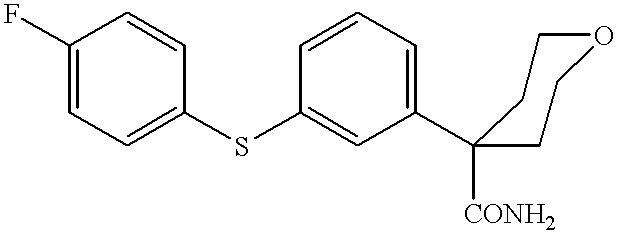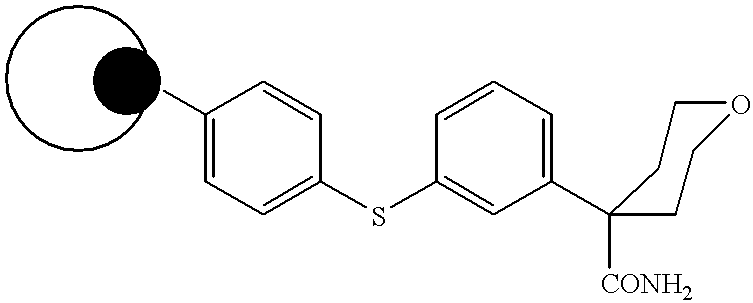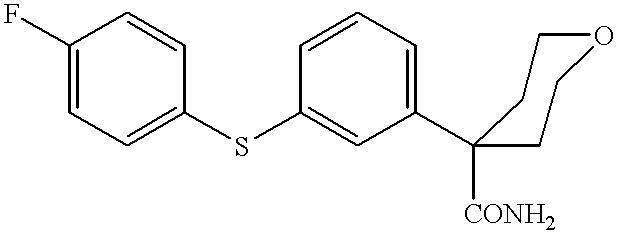Process for making 5-lipoxygenase inhibitors having varied heterocyclic ring systems
a technology of heterocyclic ring system and process, which is applied in the field of synthetic preparation of compounds, can solve the problems of high reaction temperature and low yield of displacement reactions, and achieve the effect of increasing reaction temperature and avoiding side effects
- Summary
- Abstract
- Description
- Claims
- Application Information
AI Technical Summary
Problems solved by technology
Method used
Image
Examples
example 1
Synthesis of tetrahydro-4-(3-bromophenyl)-2H-pyran-4-nitrile
3-Bromophenylacetonitrile (20.0 g, 102 mmole, 1 eq.), tetrahydrofuran (120 ml), 40% aqueous sodium hydroxide solution (180 ml, mmole, eq.), tetrabutylammonium hydrogensulfate (3.46 g, mmole, 0.1 eq.) were stirred in a reaction flask set for boiling at reflux. Thereafter, 2,2'-dichlorodiethylether (13.75 ml, 117.3 mmole, 0.1 eq.) was added with stirring at room temperature, 20-25.degree. C. The resultant reaction mixture was boiled at reflux for 5-8 h at approximately 64.degree. C. The reaction mixture was cooled to ambient temperature and ethyl acetate (154 ml) was added. The lower aqueous layer was separated and the organic layer evaporated down into a red oil. Iso-propanol (100 ml) and water (10 ml) were added to the oil and stirred at 0.degree. C. overnight to yield a crystal slurry. The crystal slurry was vacuum filtered, washed with isopropanol (2.times.20 ml). The white crystalline solid was dried under vacuum at 40-4...
example 2
Synthesis of tetrahydro-4-[3-(4-fluorophenyl)thio]phenyl-2H-pyran-4-carboxamide
Propan-2-ol (311 ml), tetrahydro-4-(3-bromophenyl)-2H-pyran-4-nitrile (51.91 g, 0.195 mole, 1 eq.), potassium hydroxide (25.16 g, 0.39 mole, 2 eq.), water (4 ml, 0.39 mole, 2 eq.), tetrakis(triphenylphosphine)palladium(0) (2.26 g, 0.00195 mole, 0.01 eq.) and 4-fluorothiophenol (25 g, 0.195 mole, 1 eq.) were added to a reaction flask set for boiling at reflux under a nitrogen atmosphere. The resultant reaction mixture was boiled at reflux for 20-24 h at approximately 82.degree. C. The reaction mixture was cooled to ambient temperature, 20-25.degree. C. and water (315 ml) was added to obtain a slurry. The crude product was isolated by filtration and washed with 1:1 water: propan-2-ol (125 ml) and sucked dry. Crude dry product was dissolved in methanol (1900 ml), treated with activated charcoal, Darco KB-B (2.5 g) and Celite filter aid (10 g) at reflux temperature, approximately 60.degree. C., for 20 min., f...
example 3
Synthesis of tetrahydro-4-[3-[4-(2-methyl-1H-imidazol-1-yl)phenyl]thio]phenyl-2H-pyran-4-carboxamide
Tetrahydro-4-[3-(4-fluorophenyl)thio]phenyl-2H-pyran-4-carboxamide(25.0 g, 75.4 mmole, 1 eq), dimethylsulfoxide (250 ml, 10 vol), 2-methylimidazole (12.39 g, 150.9 mmole, 2.0 eq) and cesium carbonate (49.16 g, 150.9 mmole, 2.0 eq) were added to a reaction flask set for boiling at reflux under a nitrogen atmosphere, and the reaction mixture was heated at 125-130.degree. C. for 17-24 h under nitrogen. After the reaction was completed it was cooled (<30.degree. C.) and quenched with water (250 ml, 10 vol), which resulted in formation of a precipitate. An exotherm of 10-15.degree. C. was observed during the water addition. The reaction slurry so formed, was cooled to room temperature (15-25.degree. C.) and then granulated for 1 h. The product was isolated by vacuum filtration and washed with water (175 ml, 7 vol). The product was dried overnight in a vacuum oven at 40-45.degree. C. Yield ...
PUM
 Login to View More
Login to View More Abstract
Description
Claims
Application Information
 Login to View More
Login to View More - R&D
- Intellectual Property
- Life Sciences
- Materials
- Tech Scout
- Unparalleled Data Quality
- Higher Quality Content
- 60% Fewer Hallucinations
Browse by: Latest US Patents, China's latest patents, Technical Efficacy Thesaurus, Application Domain, Technology Topic, Popular Technical Reports.
© 2025 PatSnap. All rights reserved.Legal|Privacy policy|Modern Slavery Act Transparency Statement|Sitemap|About US| Contact US: help@patsnap.com



